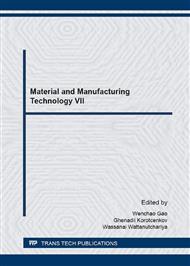p.38
p.45
p.50
p.55
p.62
p.67
p.73
p.81
p.87
Life Extension of Propeller Shafts by Hardfacing Welding
Abstract:
At present the Cut-stern Kolek Boats of local fishermen at Kaoseng Community on the Coast of Songkhla Lake have a high rate of shaft failure. Consequently, the fishermen have spent lots of money on maintenance program of repairing shafts for a few years. Besides, the repairing cost, each time of the failure also causes water pollution from the leakage of grease. The incomplete transmission of power leads to engine overloading and fuel wasting. The investigation of the high failure rate of propeller shafts which were major machine component in power transmission illustrated the failure in normal fracture caused by the mechanisms of metal fatigue. Using the welding repair by shield metal arc welding process did not give the satisfied outcome because it created the short service life of reused propeller shafts after repairing. This research was aimed to study the metal fatigue behavior of long tail shafts in the Cut-stern Kolek boats and introduce the new method of welding repair process to prolong their service life. The experiment revealed that specimens resulted from the new welding repair process and the conventional one possessed different service life. The new process used the flux core which arc welding can prolong the service life of the shafts of boats more than 1.6 times of using the conventional method which is the electric welding by flux core arc welding. The research result will be extended to fishermen, in order to encourage them to become a part of sustainable inshore fisheries.
Info:
Periodical:
Pages:
62-66
Citation:
Online since:
September 2016
Keywords:
Price:
Сopyright:
© 2016 Trans Tech Publications Ltd. All Rights Reserved
Share:
Citation:


